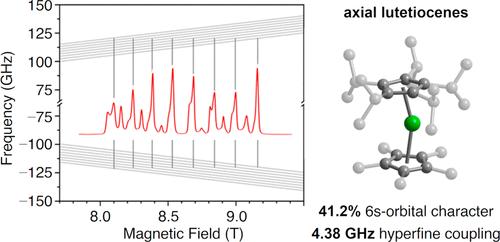一系列镥(II)茂金属配合物中伪2s基态引起的大超细耦合
IF 15.6
1区 化学
Q1 CHEMISTRY, MULTIDISCIPLINARY
引用次数: 0
摘要
合成电子自旋与核自旋之间具有强耦合的分子是分子量子信息科学的一项重要挑战。在此,我们报告了二价镥茂金属配合物 Lu(CpMe5)(CpiPr5) (CpMe5 = 五甲基环戊二烯基;CpiPr5=五异丙基环戊二烯)、Lu(CpiPr4Et)2(CpiPr4Et=乙基四异丙基环戊二烯)和 Lu(CpiPr4)2(CpiPr4=四异丙基环戊二烯)。通过单晶 X 射线衍射确定的这些复合物的分子结构具有共同的弯曲夹层几何特征,Cp-Lu-Cp 的平均夹角从 159.9°到 152.6°不等。对这些复合物的连续波电子顺磁共振(EPR)光谱进行分析后发现,它们的 g 张量几乎是各向同性的,与自由电子的 g 张量仅有轻微偏差。此外,八线谱的极大分裂表明存在强超细耦合,模拟还提供了整个系列的各向同性超细耦合常数 Aiso = 4.38、4.30 和 4.17 GHz,其中 Aiso 的值随着 Cp-Lu-Cp 角的变大而减小。值得注意的是,这些值是迄今为止在任何镧系复合物中观察到的最大值。此外,EPR 和计算分析表明,Aiso 的大值源于相应的单占分子轨道中高达 41.2% 的大 s 轨道特性。据我们所知,分子轨道中这种程度的 s 字符是迄今为止报道的开壳可分离复合物中最大的。这些结果为分离具有强超细耦合和高度各向同性双电子基态的顺磁分子勾勒出了一个通用策略。本文章由计算机程序翻译,如有差异,请以英文原文为准。

Large Hyperfine Coupling Arising from Pseudo-2S Ground States in a Series of Lutetium(II) Metallocene Complexes
The synthesis of molecules with strong coupling between electronic and nuclear spins represents an important challenge in molecular quantum information science. Here, we report the synthesis and characterization of the divalent lutetium metallocene complexes Lu(CpMe5)(CpiPr5) (CpMe5 = pentamethylcyclopentadienyl; CpiPr5 = pentaisopropylcyclopentadienyl), Lu(CpiPr4Et)2 (CpiPr4Et = ethyltetraisopropylcyclopentadienyl), and Lu(CpiPr4)2 (CpiPr4 = tetraisopropylcyclopentadienyl). The molecular structures of these complexes, as determined through single-crystal X-ray diffraction, feature a common bent sandwich geometry, with average Cp–Lu–Cp angles ranging from 159.9° to 152.6°. Analysis of continuous-wave electron paramagnetic resonance (EPR) spectra for the complexes reveals nearly isotropic g tensors with only a slight deviation from that of a free electron. Moreover, an extremely large splitting of the eight-line spectra indicates the presence of strong hyperfine coupling, and simulations provide isotropic hyperfine coupling constants of Aiso = 4.38, 4.30, and 4.17 GHz across the series, where the value of Aiso is found to decrease as the Cp–Lu–Cp angle becomes more acute. Notably, these values are the largest yet observed for any lanthanide complex. Moreover, EPR and computational analysis show that the large values of Aiso stem from large s-orbital character─up to 41.2%─in the corresponding singly occupied molecular orbitals. To our knowledge, this degree of s-character in a molecular orbital is the largest yet reported for an open-shell isolable complex. These results outline a general strategy toward the isolation of paramagnetic molecules with strong hyperfine coupling and highly isotropic doublet electronic ground states.
求助全文
通过发布文献求助,成功后即可免费获取论文全文。
去求助
来源期刊
CiteScore
24.40
自引率
6.00%
发文量
2398
审稿时长
1.6 months
期刊介绍:
The flagship journal of the American Chemical Society, known as the Journal of the American Chemical Society (JACS), has been a prestigious publication since its establishment in 1879. It holds a preeminent position in the field of chemistry and related interdisciplinary sciences. JACS is committed to disseminating cutting-edge research papers, covering a wide range of topics, and encompasses approximately 19,000 pages of Articles, Communications, and Perspectives annually. With a weekly publication frequency, JACS plays a vital role in advancing the field of chemistry by providing essential research.

 求助内容:
求助内容: 应助结果提醒方式:
应助结果提醒方式:


